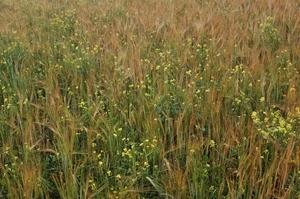Key findings
- The abundance of insects eaten by farmland birds and grey partridge chicks depended on the percentage cover and types of weeds present.
- At least 10% weed cover by desirable species is needed for insect food for grey partridge chicks.
 Ever since the pioneering research conducted in Sussex, we have known that it is predominantly the arable weeds that support chick-food insects in arable crops. A number of conservation agencies have highlighted the importance of the cropped area as a foraging place for birds and as an area with potential for increasing farmland biodiversity.
Ever since the pioneering research conducted in Sussex, we have known that it is predominantly the arable weeds that support chick-food insects in arable crops. A number of conservation agencies have highlighted the importance of the cropped area as a foraging place for birds and as an area with potential for increasing farmland biodiversity.
Over the years, we have conducted many studies where we measured the abundance of diversity of weeds and insects in crops, identifying and counting a staggering 2.4 million insects from 435 fields. Funding from the Esmée Fairbairn Foundation allowed us to analyse the data from all of these studies. We collated and interrogated the data sets to improve our advice on how best to increase insect chick-food within crops by manipulating the numbers and types of arable weeds. This work will also inform policymakers of the value of arable weeds for biodiversity. We analysed the data using a combination of statistical techniques called meta-analysis and multivariate analysis, which allow data from many different studies to be analysed together.
We found that the abundance of insects eaten by farmland birds and grey partridge chicks depending on the area covered by broadleaf and, to a lesser extent, grass weeds. There was a weaker positive relationship between total weed cover and the abundance of pest natural enemies, with grasses being more important. Having a greater number of weed species (diversity) had little effect on these relationships. Further analysis revealed that certain weed species were more important for insects than others (see Table 1).
Table 1: Importance of each weed species for insects and overall desirability based
upon argonomic issues, importance to insects and value as seed for birds
| Common name |
Importance for invertebrates |
Overall desirability |
| Annual meadow-grass |
High |
High |
| Knotgrass |
High |
High |
| Common chickweed |
High |
High |
| Black grass |
High |
Undesirable |
| Field pansy |
High |
Medium |
| Fool's parsley |
Medium |
Neutral |
| Fat-hen |
Medium |
Medium |
| Cleavers |
Medium |
Undesirable |
| Common field speedwell |
Medium |
Neutral |
| Scarlet pimpernel |
Medium |
Neutral |
| Sterile brome |
Medium |
Undesirable |
| Creeping thistle |
Medium |
Undesirable |
| Black-bindweed |
Medium |
High |
| Cut-leaved crane's bill |
Medium |
Neutral |
| Scented mayweed |
Medium |
Medium |
| Field forget-me-not |
Medium |
Neutral |
| Poppy species |
Medium |
Neutral |
| Ivy-leaved speedwell |
Medium |
Neutral |
| Bent grasses |
Some |
Neutral |
| Parsley-piert |
Some |
Neutral |
| Meadow brome |
Some |
Undesirable |
| Cock's-foot |
Some |
Neutral |
| Willowherb species |
Some |
Neutral |
| Common cudweed |
Some |
Neutral |
| Perennial rye-grass |
Some |
Undesirable |
| Redshank |
Some |
High |
| Charlock |
Some |
High |
| Mustard species |
Some |
Neutral |
| Sow-thistle species |
Some |
Medium |
| Wall speedwell |
Some |
Neutral |
| Speedwell species |
Some |
Neutral |
Chickweed, knotgrass and annual meadow grass were identified as key species because they were the species that were most often correlated with insect abundance. These were also the most common species and, although this plays a part in their influence, it is not the whole story. Species that are considered undesirable agronomically were also shown to be influential, e.g. sterile brome, creeping thistle and cleavers. Some common species (e.g. field pansy) were unimportant for insects.
There are also a number of species which are known to support insects, but were not selected by our analysis, possibly because they were not abundant enough. These were bent grasses, red and white dead-nettle (also important as early providers of pollen and nectar for bumblebees) and orache. Weed seeds are also an important food source for farmland birds, small mammals and some insects, and this should also be taken into account when assessing the desirability of different weeds.
We are often asked how much weed cover is needed to provide sufficient insects for grey partridges. This is a level of 0.7 or above on the grey partridge Chick-Food Index (CFI). We found huge variation in the percentage cover of broadleaf and grass weeds required to achieve this CFI level, but that 10% cover of the desirable weeds was likely to be sufficient (see Table 1). The crop also supported insects, so the time of cultivation and the extent of herbicide inputs also affected the weed assemblage. Consequently, each crop had its own unique composition of insects. However, this did not affect the relationships between weed levels and insects.